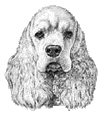 Ectropion
Ectropion
![]()
|
|
|
|
Ectropion is used to describe a condition where the lower lids are loose, causing a drooping of the eyelid's margins. The lower lids actually turn outward. One or both eyes may be involved. It can occur in any breed, but it is inherited in American Cocker Spaniels, Saint Bernards, Mastiffs and Bloodhounds. It is a heredity ailment. What are the symptoms?As the lower lid sags downward, the underlying conjunctiva is exposed. This forms a pouch or pocket, allowing pollens, grasses, dust, etc., to accumulate and rub against the sensitive conjunctiva. This is a consistent source of irritation in these dogs, leading to increased redness of the conjunctiva and occasional watering of the eye which then spills out over the lower lid and face. What are the risks?Many dogs live normal lives with ectropion. However, some develop repeated eye infections due to the collection of dirt, dust, etc., within the eye. Therefore, the risks are minor except in severe cases, where secondary eye infections may develop. What is the management?Some dogs require no treatment; however if eye irritations develop, medical attention is advisable. Mild cases can be treated with eye drops or salves to alleviate irritations and/or infections when they occur. In severe cases a surgical procedure is preferred which removes excess tissue, thereby tightening the lids and removing the abnormal pocket. Race Foster, DVM and Marty Smith, DVM
|